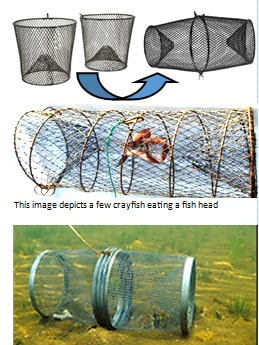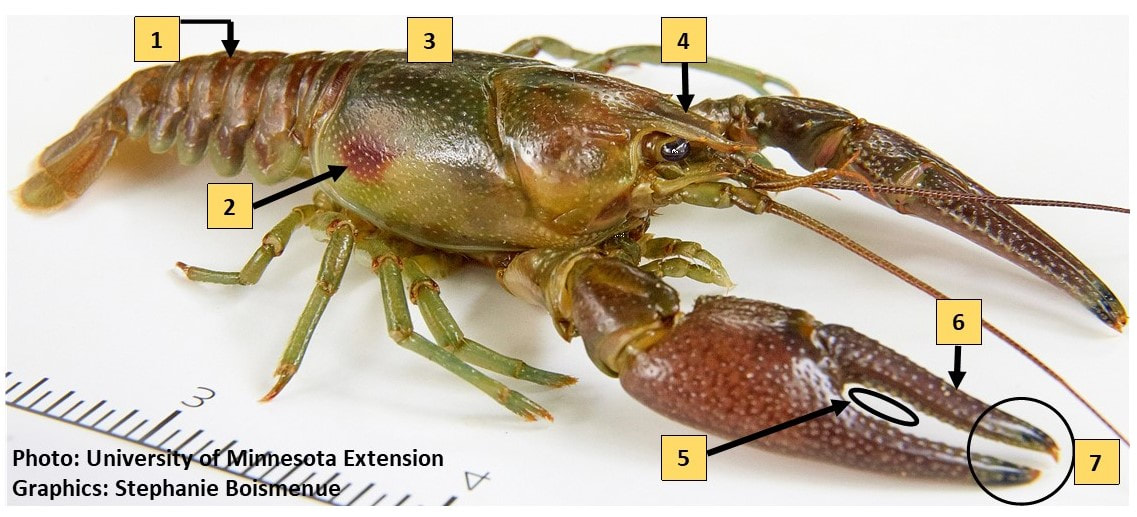Oneida County AIS Field Guide: Mystery Snails in Oneida County
- Rust colored stripe on top forward edge of the dorsal tail segments.
- Rust or brown colored spot on each side of the carapace.
- Body is gray/green to red/brown. Crayfish within the same species can vary in color.
- Rostrum between the eyes is curved inward.
- Large, smooth claws with an oval gap when closed.
- Dactyl (thumb) is S-shaped.
- Tips of claws are orange with wide black bands (Northern clearwater crayfish also has orange tips and black bands).
Description
Crayfish in Wisconsin
Wisconsin Invasive Species Rule NR 40
Crayfish Regulations
Report Invasive Crayfish
· Collect photos and report to the DNR at dnr.wisconsin.gov/topic/Invasives/report.html
- Large and aggressive non-native, invasive species in WI. Found in lakes and streams. Prefers rocky substrate.
- Native to the Ohio River Basin, they were likely introduced to Wisconsin waters by the aquarium trade and anglers discarding crayfish they were using as bait.
- Adult body length up to 5 inches (not including claws). Females can carry over 200 fertilized eggs under their tails. Once they reach maturity, males molt twice a year while females molt once after releasing their young. Can live for three or four years.
- Opportunistic feeders and will eat almost anything! They are notorious for reducing aquatic plant abundance and diversity, outcompeting native species for food and space, displacing native crayfish populations, and causing significant ecological damage.
Crayfish in Wisconsin
- Calico crayfish (Faxonius immunis) - Native to WI
- Devil crayfish (Cambarus diogenes) - Native to WI
- Northern Clearwater crayfish (Faxonius propinquus) - Native to WI. Common in Oneida County
- Prairie crayfish (Procambarus gracilis) - Native to southeastern WI
- Virile crayfish (Faxonius virilis) - Native to WI
- White River crayfish (Procambarus acutus) - Native to central and southern WI
- Red Swamp crayfish (Procambarus clarkii) - Non-native, invasive in WI. Found in southeastern WI
- Rusty crayfish (Faxonius rusticus) - Non-native, invasive in WI. Common in Oneida County
Wisconsin Invasive Species Rule NR 40
- Non-native crayfish can be incredibly invasive in natural ecosystems. Under Wis. Adm. Code s. NR 40.04(2)(c)(12), all non-native crayfish are prohibited species in Wisconsin. There is one exception, the rusty crayfish, which is considered an "established non-native crayfish" and classified as restricted.
- All live non-native crayfish may not be transported, possessed, transferred (bought or sold) or introduced in Wisconsin without a permit. DNR may grant an invasive species permit for educational or public display purposes.
- The only exception is that rusty crayfish taken from the Mississippi River may be used as bait on the Mississippi River.
Crayfish Regulations
- Wild crayfish can be captured according to the rules as described in NR 19.27, which covers seasons, methods of harvest, and bag limits.
- A fishing license or small game license is required to collect or harvest crayfish from the wild by any person age 16 or older.
- It is not legal to possess hook & line fishing gear while in possession of live crayfish on any inland waters, except for the Mississippi River.
- If the crayfish is an invasive species (rusty crayfish), it must be immediately killed before a person can keep it.
- A bait dealer license is required to sell crayfish (live or dead) as bait for fishing
Report Invasive Crayfish
· Collect photos and report to the DNR at dnr.wisconsin.gov/topic/Invasives/report.html

How to Effectively Trap Crayfish
Step 1: Setting up your trap
Connect two of the crayfish traps together via zip-ties or fishing line. The largest part of the traps should be touching each other while the smaller holes are pointing outside on each side. This ensures that the crayfish can enter the trap but cannot leave the trap.
Step 2: Baiting your trap
The Rusty Crayfish is a heavy eater and will luckily almost eat anything you throw its way. However, most common crayfish bait is unwanted fish parts, hotdogs, or fish-based cat food. You can feed this bait in through the little holes on either side of the trap or put the bait in the trap before connecting the two traps together.
Step 3: Placing your trap
Now that you have your trap baited and ready to go. You must find a place to place it. If you are in an area of running stream water. Place the trap vertical to the flow so that one of the small holes is in line with the fasted flow of water. If you are in still water (I.E a lake) place the trap vertical to the water’s edge. You will want to mark where your trap is weather with brightly colored cord or with a makeshift buoy made out of a plastic jug.


